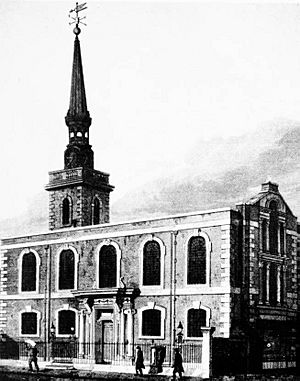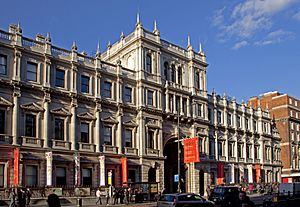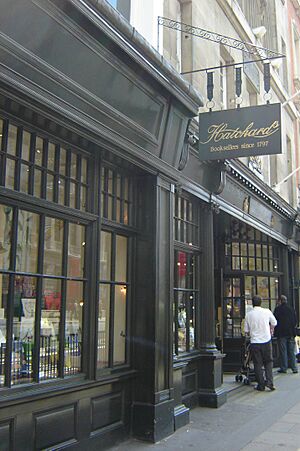Piccadilly facts for kids
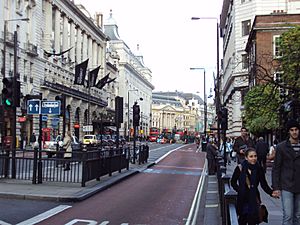
Piccadilly is a famous road in London, England. It's located in the City of Westminster, south of an area called Mayfair. Piccadilly stretches from Hyde Park Corner in the west to Piccadilly Circus in the east.
This road is part of the A4 road. This important route connects central London to places like Heathrow Airport. Piccadilly is almost 1 mile long. It's one of the widest and straightest streets in central London.
Piccadilly has been a main road for a very long time, even since the Middle Ages. Back then, people called it "the road to Reading". Around 1611, a man named Robert Baker bought land here. He became rich by making and selling "piccadills," which were a type of stiff collar. He built houses, including his own home, called Pikadilly Hall.
In 1663, the street was named Portugal Street. This was to honor Catherine of Braganza, who was the wife of King Charles II. The road became even more important after a path from Charing Cross to Hyde Park Corner was closed in 1668 to create Green Park.
Many grand homes were built on the north side of Piccadilly during this time. These included Clarendon House and Burlington House. Berkeley House was built around the same time. It burned down in 1733 and was rebuilt as Devonshire House in 1737. This house was later used by the Whig party, a political group.
Today, Burlington House is home to several important groups. These include the Royal Academy of Arts, the Geological Society of London, and the Royal Astronomical Society. Many members of the wealthy Rothschild family also had large houses on Piccadilly. St James's Church was built in 1684.
The Old White Horse Cellar at No. 155 was a very famous inn for coaches in the late 1700s. By then, Piccadilly was also known for its many booksellers. The Bath Hotel opened around 1790, and Walsingham House was built in 1887. Both of these were later bought and taken down. The famous Ritz Hotel was built in their place in 1906.
Piccadilly Circus station opened in 1906. It was rebuilt between 1925 and 1928. The clothing store Simpson's opened on Piccadilly in 1936. Today, Piccadilly is one of London's main shopping streets. Famous places here include the Ritz, Park Lane, Athenaeum and Intercontinental hotels. You can also find Fortnum & Mason, the Royal Academy, Hatchards bookshop, and the Embassy of Japan.
Piccadilly has appeared in many stories and books. It's even one of the squares on the London Monopoly board game!
Contents
History of Piccadilly
How Piccadilly Got Its Name
Piccadilly has been a main road for hundreds of years. In the Middle Ages, people knew it as "the road to Reading". During the Tudor period, London started to grow outside its old city walls.
Around 1611, a tailor named Robert Baker bought some land here. He became very successful by making and selling "piccadills." These were a type of fancy, stiff collar that was popular at the time. After buying the land, he built several homes, including his own house. Within two years, his house was known as Pikadilly Hall. This is how the area got its famous name!
A map from 1658 called the street "the way from Knightsbridge to Piccadilly Hall." There was also a popular gaming house nearby called Shaver's Hall, sometimes nicknamed "Pickadell Hall."
Piccadilly in the 1600s
In 1663, the street was officially named Portugal Street. This was in honor of Catherine of Braganza, the wife of King Charles II. The road became even more important for travel after a path from Charing Cross to Hyde Park Corner was closed in 1668. This closure allowed for the creation of Green Park.
After the king returned to power in 1660, he encouraged building in this area. Portugal Street and the area to the north (Mayfair) became very fashionable places to live. Some of London's grandest houses were built on the north side of the street.
Edward Hyde, 1st Earl of Clarendon, a close advisor to the king, built Clarendon House in 1664. This house is now where Albemarle Street is located. Sir John Denham built what later became Burlington House. He chose the spot because it was on the edge of London, surrounded by fields. Burlington House was later rebuilt and has been home to many important groups.
Berkeley House was built around the same time. It was destroyed by a fire in 1733. It was rebuilt as Devonshire House in 1737. This grand house was later used as the main meeting place for the Whig party. Devonshire House was eventually sold in 1921.
Today, Burlington House is home to the Royal Academy of Arts, the Geological Society of London, and the Royal Astronomical Society.
St James's Church was first planned in 1664. People living there wanted their own church separate from St Martin in the Fields. Building began in 1676. The famous architect Christopher Wren designed the church. It cost about £5,000 and was finished in 1684. The area around it then became its own parish.
By 1680, most of the first homes on Portugal Street had been changed or rebuilt. The name Piccadilly was used for part of the street by 1673. Eventually, it became the name for the whole road. A map from 1720 called the road "Portugal Street aka Piccadilly." By 1746, maps showed the entire street as Piccadilly.
Piccadilly in the 1700s and 1800s
Piccadilly continued to grow. By the mid-1700s, buildings lined the street all the way to Hyde Park Corner. Because of the growth of nearby areas like St James's and Mayfair, Piccadilly became one of London's busiest roads.
Hugh Mason and William Fortnum started their famous shop, Fortnum & Mason, on Piccadilly in 1705. They began by selling recycled candles from Buckingham Palace. By 1788, their store sold many fancy foods.
During this time, Piccadilly became known for its many inns and pubs. The Old White Horse Cellar at No. 155 was one of England's most famous inns for coaches. It was later taken down. The Bath Hotel opened around 1790, and Walsingham House was built in 1887. Both of these were demolished to make way for the luxurious Ritz Hotel, which opened in 1906.
Many members of the wealthy Rothschild family had large homes at the western end of the street. Nathan Mayer Rothschild moved his banking business to No. 107 in 1825. Because so many grand buildings with ballrooms and marble stairs were built, people sometimes called the street "Rothschild Row."
Melbourne House was built between 1770 and 1774. In 1802, it was turned into apartments and is now called the Albany. This building has been home to two British Prime Ministers: William Ewart Gladstone and Edward Heath.
St James's Hall was built between 1857 and 1858. Famous writer Charles Dickens gave readings of his novels here. Many famous musicians, like Antonín Dvořák and Pyotr Ilyich Tchaikovsky, also performed in the hall. It was taken down in 1905 and replaced by the Piccadilly Hotel.
In the late 1700s, Piccadilly was a popular place for booksellers. The oldest bookshop still open in Britain, Hatchards, was started by John Hatchard at No. 173 in 1797. It moved to its current spot at No. 187 in 1801.
The Egyptian Hall at No. 170 was built in 1812. It looked like ancient Egyptian buildings. It was a place for art shows and had many Egyptian artifacts.
Piccadilly in the 1900s and 2000s
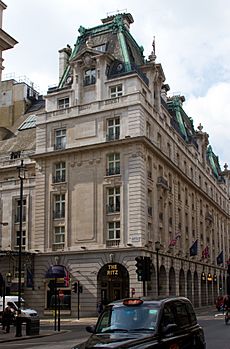
By the 1920s, most of the old homes on Piccadilly had been replaced or were used by businesses. The noise from traffic had made it less appealing for people to live there. However, a few homes remained. Albert, Duke of York, who later became King George VI, lived at No. 145 when he became king in 1936.
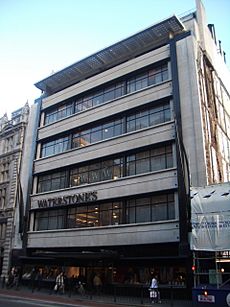
The clothing store Simpson's opened at 203-206 Piccadilly in 1936. It was known for its factory-made men's clothing. The building had a modern design. When it opened, it was said to be the biggest menswear store in London. Simpson's closed in 1999. Its building is now the main store for the booksellers Waterstones.
In 1968, a group of people called squatters used a building at No. 144. They took advantage of a law that allowed empty buildings to be used as emergency shelters for people without homes. This led to new rules for organizations that could take over empty places to help the homeless.
Today, Piccadilly is a major shopping street in London. It has several famous shops and luxury hotels. These include the Ritz Hotel, the Park Lane Hotel, the Athenaeum Hotel, and Intercontinental Hotels. In the past, Piccadilly had many gentlemen's clubs. Now, only a few remain, like the Cavalry and Guards Club and the Royal Air Force Club.
Getting Around Piccadilly

Piccadilly is a very important road in the West End of London. It has several major road crossings. To the east, Piccadilly Circus opened in 1819. It connects Piccadilly to Regent Street. Piccadilly Circus is now one of London's most famous landmarks. It has a statue of Eros and large electric signs.
At the western end of Piccadilly is Hyde Park Corner. Piccadilly also has important crossings with St James's Street, Albemarle Street, Bond Street, and Dover Street.
The road is part of the A4. This road links central London to places like Heathrow Airport. Traffic on Piccadilly has been a problem since the mid-1800s. This led to the road being made wider. Traffic signals were put in during the 1930s. In the late 1950s, Hyde Park Corner was changed to help traffic flow better. This project finished in 1962.
Many London bus routes travel along Piccadilly. These include routes 6, 9, 14, 19, 22, and 38. There are also night bus routes. Special lanes for buses were added in the 1970s.
Part of the Piccadilly line on the London Underground runs beneath the street. Three tube stations on the Piccadilly line have entrances on or near Piccadilly: Green Park, Hyde Park Corner, and Piccadilly Circus. In Spanish: Piccadilly para niños
In Spanish: Piccadilly para niños



